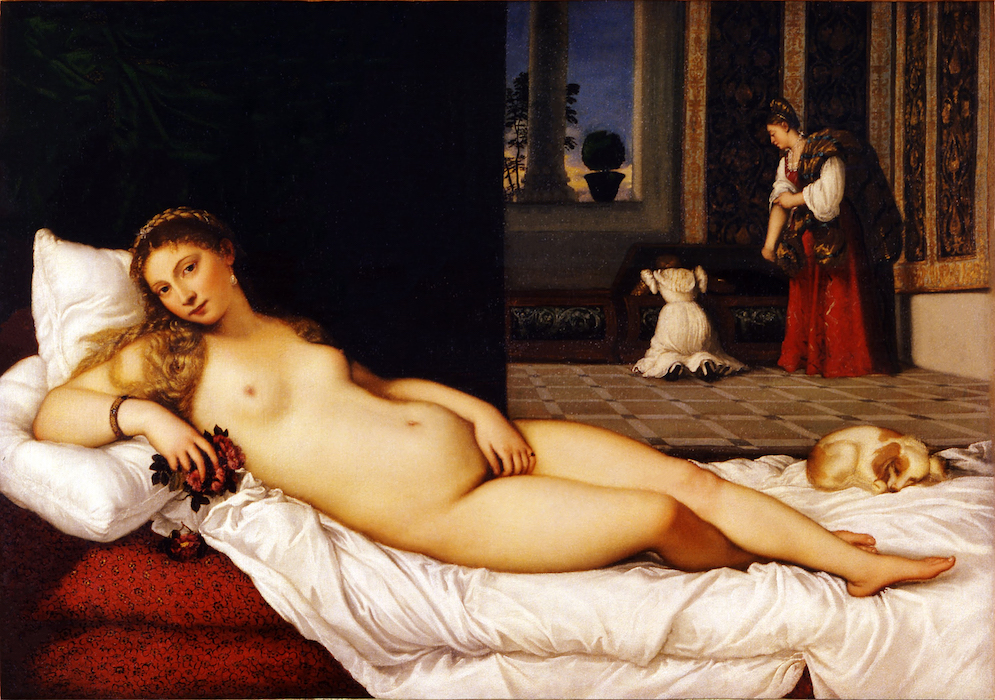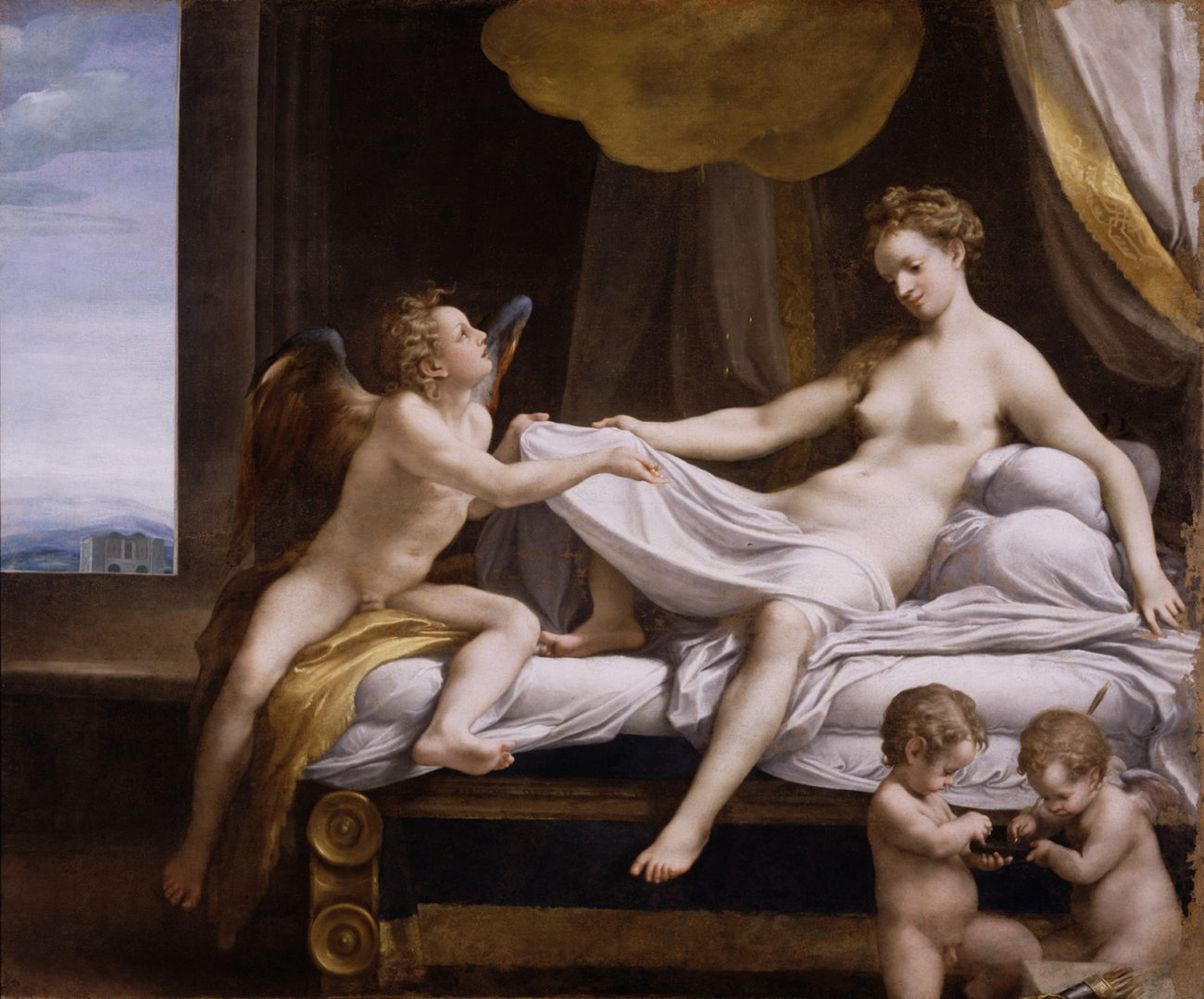Pictures of nude women confront us in art museums, advertisements, movies — seemingly everywhere. And yet when women’s bodies are unclothed in situations not intentionally designed for the visual pleasure of heterosexual male onlookers — while feeding an infant, or during a quick change to provide relief to an athlete during a match — social disapproval is more likely to follow. The special space geared to the “male gaze” carved out for certain kinds of erotic imagery in Western culture is well over 500 years old: it was explicitly theorized and codified in the late Middle Ages and Renaissance.
Renaissance artist Titian, for example, played a major role in popularizing a type of female nude that has become familiar to us, the centerfold. A woman is shown naked, with soft, almost boneless, flesh, splayed out across the front of the picture plane, luxurious tresses contrasting with a complete lack of body hair. The centerfold either invites the viewer with a come-hither look or averts her gaze so that the viewer can indulge in the voyeuristic pleasure of seeing without being seen.
Male nudes in the Renaissance, by contrast, were muscled, active, confident, athletic. Michelangelesque male nudes personify masculine power in the world, as exemplified by this bronze sculpture of the Greek hero Hercules and the giant Antaeus, which appears in the exhibition The Renaissance Nude.
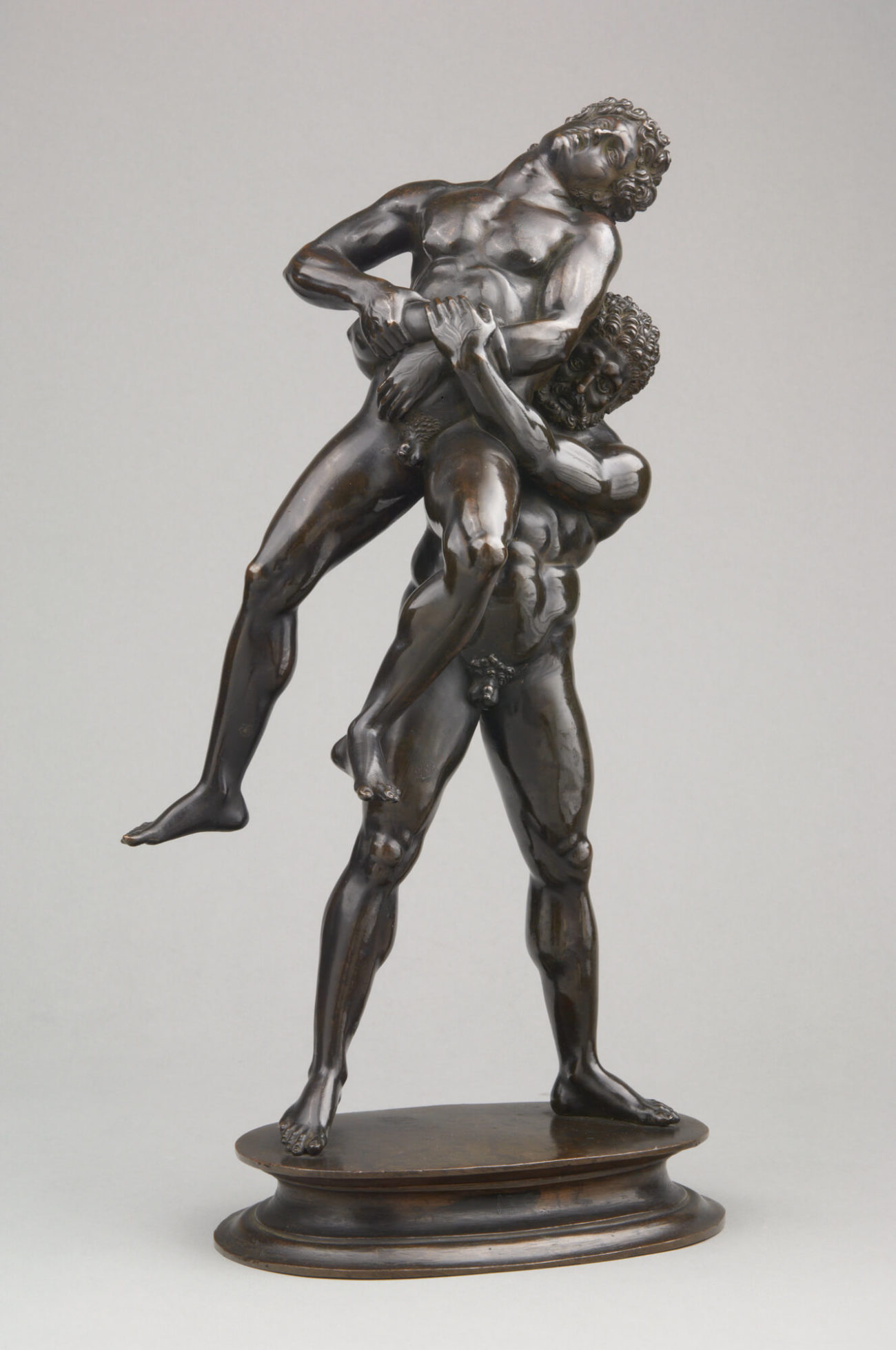
Antico, Hercules and Antaeus, c. 1519, bronze, 17 inches high (KHM-Museumsverband / Kunsthistorisches Museum, Vienna)
This exhibition asks us to think about the cultural implications and real-world consequences of representing and displaying the unclothed body and offers an opportunity to have much-needed discussions about the complicated, difficult legacy of the European convention of representing the nude. The #MeToo movement is forcing us to reassess many aspects of our cultural heritage that, upon second look, do not seem as harmless, as acceptable, as admirable, as beautiful, or as “cultured” as they did before.
This post offers four lenses through which twenty-first-century viewers might critically examine the nude in Renaissance art.
The nude and the objectification of women
Just as the first readers of Playboy claimed to read it for the articles, the men promoting Humanism in the Renaissance attempted to intellectualize the genre of the pliant female nude. Well into our era, male art historians such as Erwin Panofsky still encouraged us to see the female nudes of the Renaissance as Humanist meditations on Neoplatonic philosophy, to think of them principally as Ideas that are only incidentally shown enfleshed in smoking-hot bods.
Take the Venus Anadyomene by Titian. It shows the “foam-born” goddess rising from the waves as a woman at her bath, coyly glancing to the side as she wrings her hair away from her body so as to expose her fleshy breasts and pubis. By taking on this subject, Titian compares himself to Apelles, the Greek artist lauded by Ovid and others for his famous painting of Venus rising naked from the sea. She may be an erudite reference to ancient sources and learned discourses about fame, nature, divinity, and immortality, but she is also Titian’s erotic ideal.
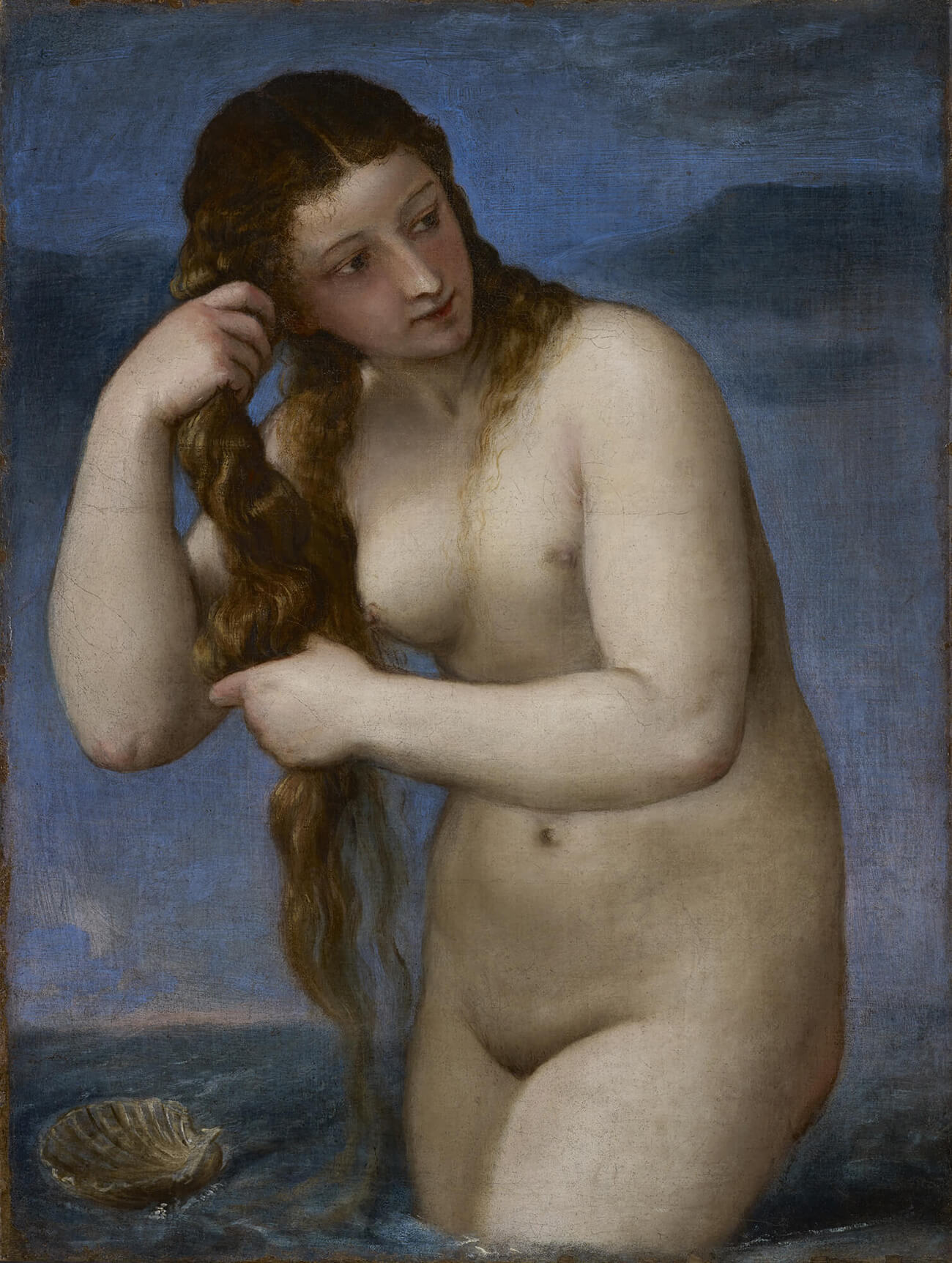
Titian, Venus Rising from the Sea (Venus Anadyomene) , c. 1520, oil on canvas, 29 13/16 × 22 11/16 inches (National Galleries of Scotland, Edinburgh)
By men and for men, such imagery was not designed for the female gaze; rare exceptions notwithstanding, the Renaissance nude did not intentionally engage female agency, subjectivity, desire, and sexuality. Born to stimulate homosocial philosophizing, the Renaissance nude shaped notions of masculinity, forcing male viewers to contend with complex feelings like lust, and uneasiness about that lust.
The nude and violence against women
Masculine anxieties embodied in the Renaissance nude had terrifying consequences for real-life women. Images of bewitching Venuses were not too distant in the minds of the men who commissioned and created them from women they thought to be actual witches — they believed them to be in league with the devil to tempt, emasculate, and damn Christian men.
The overlap between idealized female nudes and demonic temptresses is illustrated by Hans Baldung Grien’s Two Witches . There’s nothing in particular about the bodies themselves — posed to provide titillating front and back views of fleshy females — that distinguish them from the idealized nudes that spiced up the scholarly conversations taking place in male-dominated Humanist circles. A few strategic embellishments suggest that women are easily changed into dangerous creatures: a shift in palette towards unnatural fiery hues; the addition of animal and supernatural familiars (goat and putto ); a nasty creature housed in an alchemical vessel; a storm symbolically brewing in the background.

Hans Baldung Grien, Two Witches, 1523, oil on bass wood, 30 13/16 × 23 11/16 inches (Städel Museum, Frankfurt am Main)
Not only were witches a familiar subject among the Humanists in early-sixteenth-century Strasbourg, where Baldung Grien worked, but the artist’s father was also a jurist who worked for the bishop of the surrounding diocese. In this diocese 5,000 women were burned for witchcraft between 1515 and 1535. Art historian Joseph Koerner draws the conclusion that by confirming “the misogynist double fantasy that all witches are women and all women are potentially witches,” [1] Baldung Grien’s nudes exacerbated the misogynist atmosphere that resulted in the massacre of thousands of women.
The exhibition The Renaissance Nude provides examples of a whole range of subjects favored in the Renaissance that blamed and vilified women while simultaneously putting their beauty on display for the male gaze: not only witches, but Eve, Bathsheba, pagan goddesses, and personifications of Vanity and Lust. The not-so-subtle subtext is this: when confronting such sexy, tempting beauty, how can men be expected to resist?
“Heroic rape” was a common motif in the Renaissance and beyond, depicting women as vulnerable, even coyly receptive, to nonconsensual sex. [2] In Correggio’s painting of Danaë in the exhibition, the princess reclines naked in her luxurious bed, eyes cast down modestly as Jupiter’s acolyte, Eros, exposes her languid body to the god, who descends in the form of a golden cloud to ravish her. Such images sanitized and normalized rape. They functioned for the powerful men who commissioned them as a way to assert dominance in various social, political, and personal contexts.
The nude and white, male power
To understand how the Renaissance nude reinforced the power of white European men—to the detriment of others—let’s look more closely at what “the nude” really is. In this essay I have been using the words “naked,” “nude,” and “unclothed” as more or less interchangeable, but they are not exactly the same. “The nude” is a certain type of idealized body that does not exist in reality.
The most influential modern apologist for the nude was Sir Kenneth Clark, the famed National Gallery director, Oxford professor, and host of the BBC series Civilisation. Clark’s book The Nude has never gone out of print, and in 2016 was #27 on the Guardian’s list of best nonfiction books. According to Clark, the nude is “the body re-formed.” As he wrote, “in the greatest age of painting, the nude inspired the greatest works.” [3]
Female artists do not appear in Clark’s book, or in his concept of great art. Why not? Art historian Linda Nochlin pointed out that in most of modern European history women were barred from the kind of training that enabled them to make art considered by contemporaries to be great. [4] They were not permitted to draw from live models, and thus lacked opportunity to be trained to create the paintings most valued—and likely to be recognized as “great”—by academics and patrons: historical, mythological, and religious subjects demanding artistic mastery of the human body. Nochlin’s feminist reading resists the dominant narrative of the great artist, the “genius” who is gendered male in patriarchal societies. She gives many examples of exceptional female artists not recognized as “great” during their lifetimes due to structural inequalities, but whose work deserves reappraisal.
Neither does the Renaissance nude as a construct acknowledge the agency and personhood of people of color. When subjects of color were represented without clothes in European art of this era, it was typically to emphasize European ideas about their superiority over non-European savages (including “noble” savages). Tellingly, the very first paragraph of Clark’s book, The Nude, sets up a contrast between the “great” art of colonial powers and the “artless” visual traditions of “islanders”—in other words, of non-European cultures.
Art historian Jill Burke has suggested that Antonio Pollaiuolo’s famous Battle of the Nudes from the 1470s was inspired by an account of hand-to-hand combat among Senegalese nobles written by the Venetian explorer and slave trader Alvise Cadamosto. The men in Pollauiolo’s print brandish the short, curved Moorish swords described by Cadamosto, and their fierce expressions and violent actions seem to conform to Cadamosto’s characterization of them as “daring and bestial.”
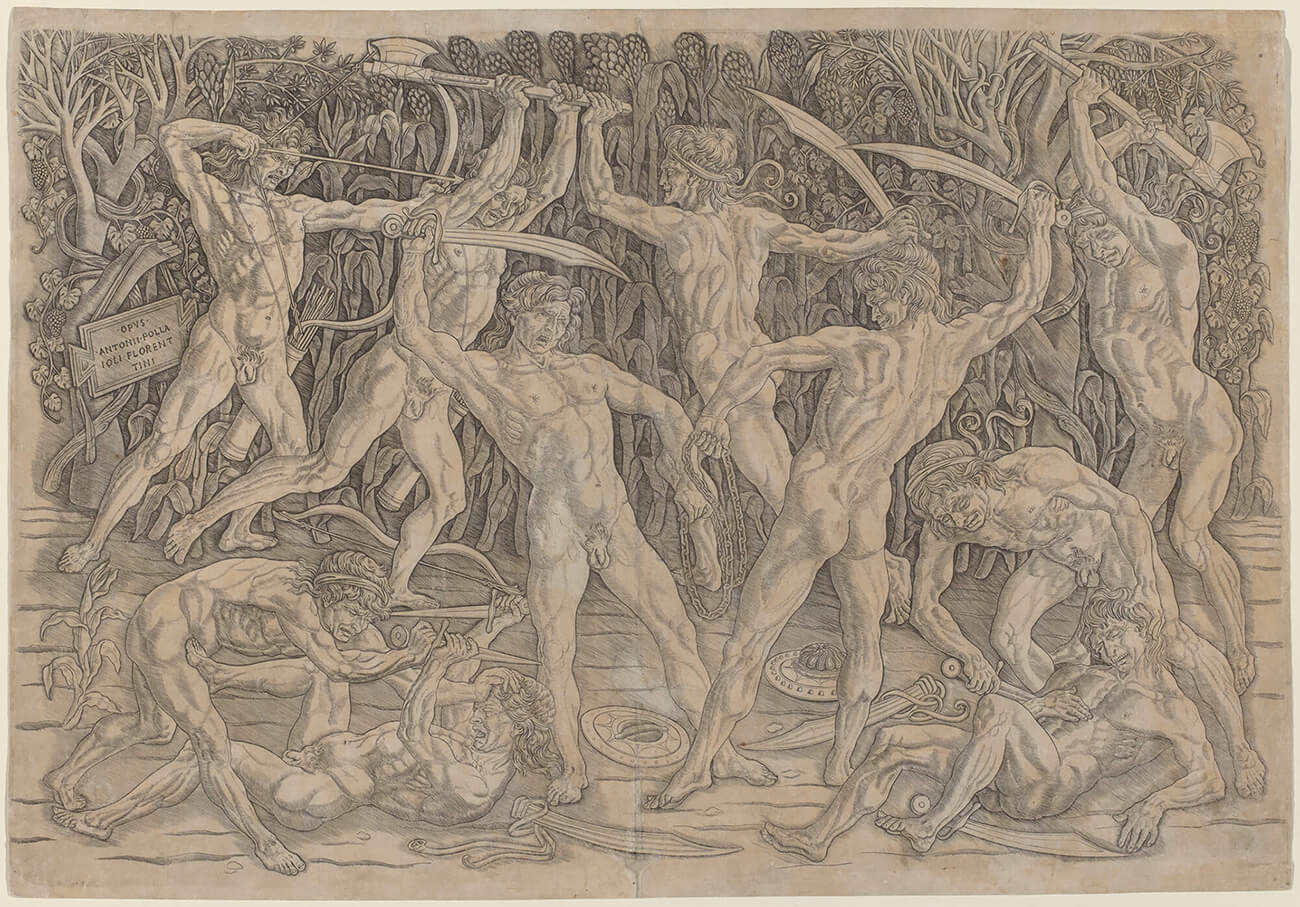
Antonio Pollaiuolo, Battle of the Nudes , 1470–75, engraving, 16 7/8 × 24 5/16 inches (National Gallery of Art, Washington, DC)
The Renaissance nude as a category is potentially harmful as traditionally understood because it privileges the heterosexual European male viewer and promotes a narrow range of what type of body is to be considered desirable: youthful, healthy, able-bodied, light-skinned. The Renaissance Nude —the exhibition — is conceived more broadly, and offers a valuable opportunity to reassess.
The nude and transgressive viewing
We can create new meanings for the Renaissance nude by acknowledging that such imagery could have been, and might still be, read in ways that were not necessarily intended.
For example, although European societies in the early modern period outlawed and punished homosexual acts, art could nevertheless serve same-sex attraction. It is well documented that prominent Renaissance artists such as Michelangelo engaged in passionate same-sex relationships — even though we cannot always know whether such relationships were consummated sexually.
Certain Renaissance nudes, while ostensibly reinforcing public Heteronormativity, offered opportunities for a queer, or transgressive, visual experience. The half-nude flagellants that the Limbourg Brothers painted in the Duke of Berry’s personal prayer book in the exhibition enable viewers to admire handsome youths in vulnerable positions; at the time the duke was criticized for inappropriate relationships with young men — possibly the Limbourg Brothers themselves. [5]
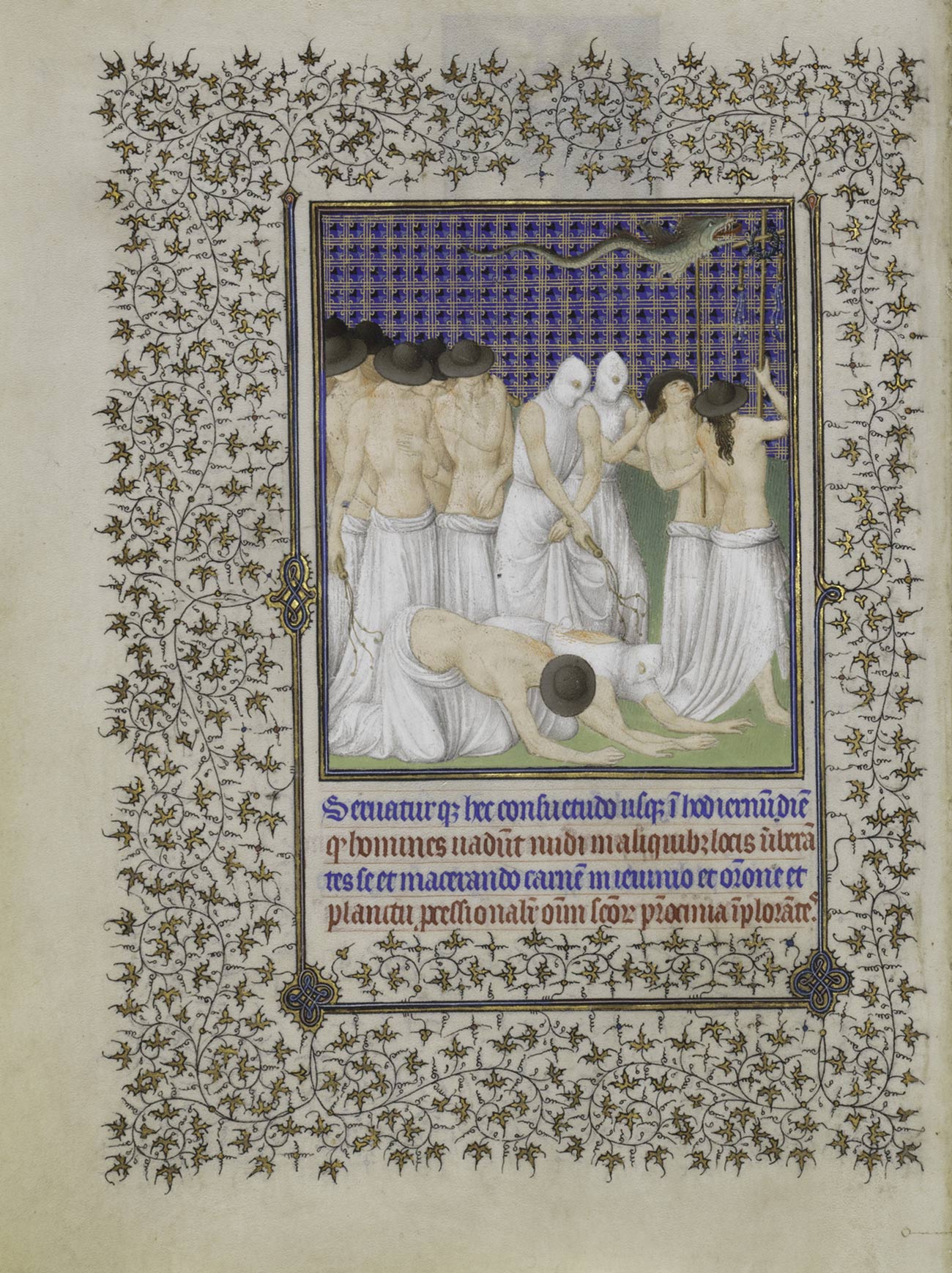
The Limbourg Brothers, Procession of Flagellants in The Belles Heures of Jean de France, duc de Berry, 1405–1408/1409, tempera, gold, and ink on vellum, 9 3/8 x 6 11/16 inches (The Metropolitan Museum of Art, The Cloisters Collection)
John Berger, the author of the influential book and BBC series Ways of Seeing, thought it possible to recognize in some imagery of naked bodies “the element of banality…which distinguishes between voyeur and lover.” [6] A revelation of a woman at her daily prayer by Albrecht Dürer might qualify. Certain details are moving precisely because of their ordinariness: her loosely joined fingers, the folds of skin behind her knees, the uneven contours of her ample hips and thighs.
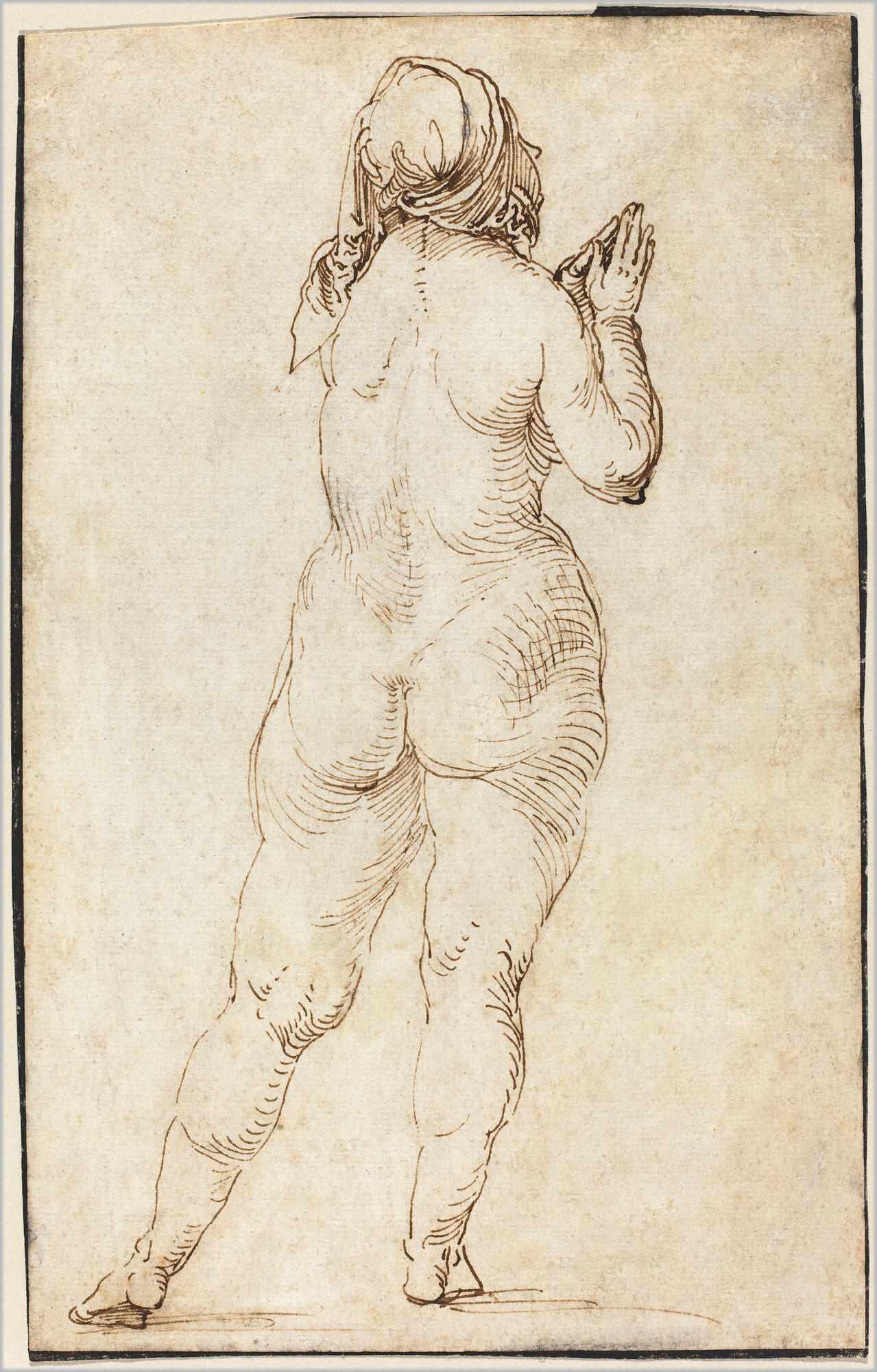
Albrecht Dürer, Female Nude Praying , c. 1500, pen and brown ink on laid paper; 21.5 × 13.6 cm (National Gallery of Art, Washington, DC)
As the exhibition shows in numerous works, Renaissance artists explored the meanings of aging, suffering, pregnant, and ascetic bodies, imbuing the human body with an emotional power very different from that evoked by nudes of muscular heroes or erotic goddesses.
An alternative approach to the Renaissance nude
We need not enter museums ready to celebrate products of artistic “geniuses” as torchbearers for idealized “civilizations.”
Should we not evaluate masterpieces in the history of art with an informed critical eye?
Should we not experiment with seeing artworks against the grain — to enjoy them, perhaps, in ways their creators did not intend and might not have approved of?
Should we not form fresh insights about a seductive and destructive aesthetic and use them in new creative works that shape more expansive, accepting, diverse, generous, including, and egalitarian notions of what is beautiful and erotic, poignant and moving, about human bodies?
Yes. We should.
This essay first appeared in the iris (CC BY 4.0).
Notes:
- Joseph Koerner, The Moment of Self-Portraiture in German Renaissance Art (1993), pp. 328–9.
- Diane Wolfthal, Images of Rape: The “Heroic” Tradition and Its Alternatives (1999).
- The Nude: A Study in Ideal Form , 1984; reprint 1956, p. 3.
- “Why Have There Been No Great Women Artists ?,” Linda Nochlin, 1973.
- Sherry CM Lindquist, “Masculinist Devotion: Flaying and Flagellation in the Belles Heures,” in Flaying in the Premodern World (2017).
- Ways of Seeing (1972), p. 61.

